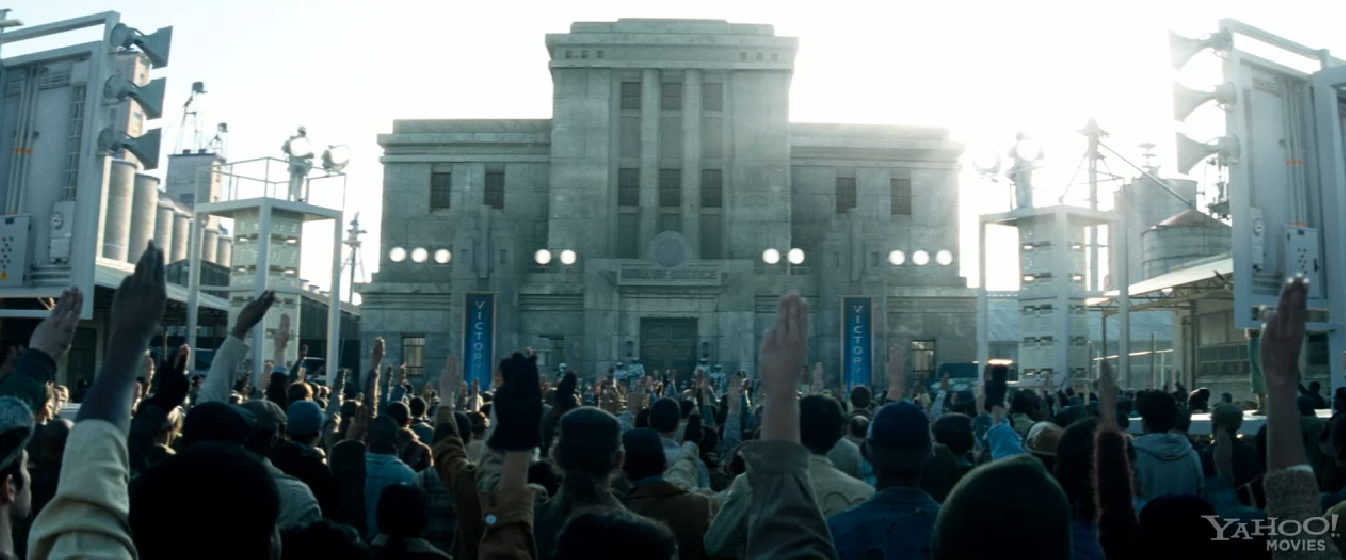The Capitol’s Mirror: Symbolism and Real-World Reflections in The Hunger Games
The Hunger Games, directed by Gary Ross and adapted from Suzanne Collins’ bestselling novel, is a captivating film that delves into themes of survival, oppression, and rebellion within a dystopian society. Classified as science fiction for young adults, particularly those familiar with the book series, the film also weaves in substantial drama. From its clever foreshadowing to evocative imagery and the symbolic conclusion involving Seneca Crane, The Hunger Games offers a rich commentary on pressing issues. Through the use of symbolism and intentional parallels to the real world, the film crafts a compelling portrayal of a powerful dystopian society.
The Hunger Games follows Katniss Everdeen on her journey through the 74th annual Hunger Games—a brutal competition where 24 children aged 12-18 fight to the death. Katniss’s world is shattered when her younger sister, Primrose, is chosen during the Reaping, an annual event where one boy and one girl from each district are selected as tributes. Facing the grim reality that Prim will be forced into a fight for survival, Katniss makes a life-altering decision. In a moment that echoes through the minds of many teenagers, she volunteers herself with the solemn words, ‘I volunteer as tribute.’ This selfless act thrusts Katniss into the deadly arena, where she must confront 23 other tributes, including a boy from her own district. Amidst the chaos of the Games, a love confession from fellow tribute Peeta Mellark and tense training sessions with other tributes add layers of complexity to the narrative. Throughout the perilous journey, Katniss and Peeta forge an unexpected alliance, defying the tradition of only one victor each year. Despite emerging as the victors, with the chance to return to District 12, their lives take a haunting turn. President Snow, the ruthless dictator of Panem, responds to their victory by killing the head gamemaker of the 74th Hunger Games and plotting revenge against Katniss Everdeen.

While the social commentary in The Hunger Games is what made so many people love it, another reason it was so popular is the fact that it is a splendid example of a science fiction movie. The Hunger Games effectively combines science fiction, dystopia, and coming of-age. In the genre of young adult films, it still stands up. With its masterful and engaging narrative, strong character development, and social commentary, The Hunger Games is a notable example of a good young adult film and how they can be adult yet appeal to teens. The Hunger Games serves multiple purposes as a film. Primarily, it strives to captivate audiences through its riveting plot and dynamic action sequences, typical of the thriller genre. A compelling example of this is seen when Katniss, faced with the challenge of fighting the Mutts for her life, must simultaneously rescue Peeta from Kato. Beyond mere entertainment, the film stands as an insightful commentary on societal issues. It skillfully draws parallels between the dystopian world of Panem and real-world problems such as class inequality. Notably, it adeptly showcases the stark contrast in social status by narrating the story from the perspective of Katniss, a disadvantaged girl hailing from District 12, the poorest district.
The impact of The Hunger Games is significantly heightened by its adept use of dramatic elements. Tension, suspense, and emotional depth are seamlessly integrated into the narrative. The stark societal disparities are effectively portrayed through the contrast between the opulent Capitol and the impoverished districts. This dichotomy is vividly illustrated in the extravagant clothing of the Capitol residents versus the modest attire of the miners and townspeople in District 12 during the reaping. Despite dressing in their best attire for a potentially deadly competition, the residents of District 12 still pale in comparison to Capitol fashion. The film’s impactful portrayal is further accentuated by the pivotal role played by dramatic elements. Tension, suspense, and emotional depth are consistently interwoven throughout the narrative, resulting in a captivating viewing experience.

It’s important to acknowledge that The Hunger Games owes much of its dystopian YA movie essence to Jennifer Lawrence’s portrayal of the protagonist, Katniss Everdeen. She emerges as a captivating and relatable character, embodying the face of rebellion against the oppressive Capitol. Initially embodied by President Snow and the tyrannical Capitol regime, the antagonist role gradually broadens to encompass the wider system of societal control.The interplay between the protagonist and antagonist in The Hunger Games also carries symbolic weight. President Snow and the Capitol serve as representations of oppressive control and exploitation, mirroring real-world power structures that fuel inequality. Katniss’s evolution from a reluctant participant to a symbol of rebellion mirrors the resilience of individuals against such systems, echoing real-life narratives of resistance. Moreover, the setting plays a crucial role in shaping the narrative. The story unfolds in a dystopian future version of North America, where the Capitol holds sway over twelve districts. The annual Hunger Games, a televised event featuring young representatives from each district fighting to the death, stands as a somber reminder of the Capitol’s authority.
Along with other thematic elements, symbolism plays a significant role in The Hunger Games. Katniss Everdeen emerges as a symbol of resistance against the oppressive regime of the Capitol. Her defiance and unwilling participation in the Hunger Games mirrors real-world individuals who stand up against injustice. Furthermore, Katniss’s Mockingjay pin becomes an emblem of hope and rebellion, resonating with viewers on a symbolic level. Another fitting example of symbolism is the opulence of the Capitol, the center of Panem and the richest area in the whole country, starkly contrasting with the poverty found in the districts. The Capitol and District 12 have entirely different looks, with 12 being dark, gloomy, and having thin people who look like they are starving, while the Capitol folk are dressed brightly, with wild makeup and smiles on their faces, thin because it is popular, not because they must be.
The thematic richness of The Hunger Games is further deepened by its resonances with real-world issues. Take, for instance, the annual Hunger Games, broadcasted for the Capitol’s entertainment, which draws a parallel to the desensitization of violence in modern media. In a striking reflection of reality, Capitol residents place bets on the Victors, send gifts, and even the lower districts are obligated to watch the games during their off-duty hours. The Capitol’s manipulation of public opinion through the Games mirrors the power dynamics and propaganda strategies employed by authoritarian regimes, echoing contemporary concerns about media manipulation. The film portrays characters like Gale and Prim watching the games, prompting Katniss to question the necessity of this annual ritual. Gale’s comment at the movie’s outset encapsulates the districts’ disdain for the government-imposed laws: “You root for your favorites and cry when they get killed.” It serves as a poignant example of the resentment harbored by the districts towards the oppressive government regulations

In conclusion, The Hunger Games goes beyond its genre by employing symbolism, thought-provoking parallels to the real world, compelling characters, impactful visuals, and a well-crafted narrative. It’s not just a captivating work of fiction; it serves as a mirror reflecting persistent societal issues. The novel prompts readers to critically examine systems and structures shaping our societies, addressing economic disparities, political manipulation, media influence, and environmental degradation. Under Gary Ross’s direction and Susan Collins’s guidance, The Hunger Games transforms into more than just an entertaining movie; it becomes a critical commentary on societal issues, urging audiences to reflect on its underlying messages. Through its symbols and parallels, The Hunger Games remains a relevant and impactful cinematic exploration of power, inequality, and the resilience of the human spirit. As we face our own challenges, the film encourages us to be vigilant, question authority, and strive for a world where justice, equality, and compassion prevail.







